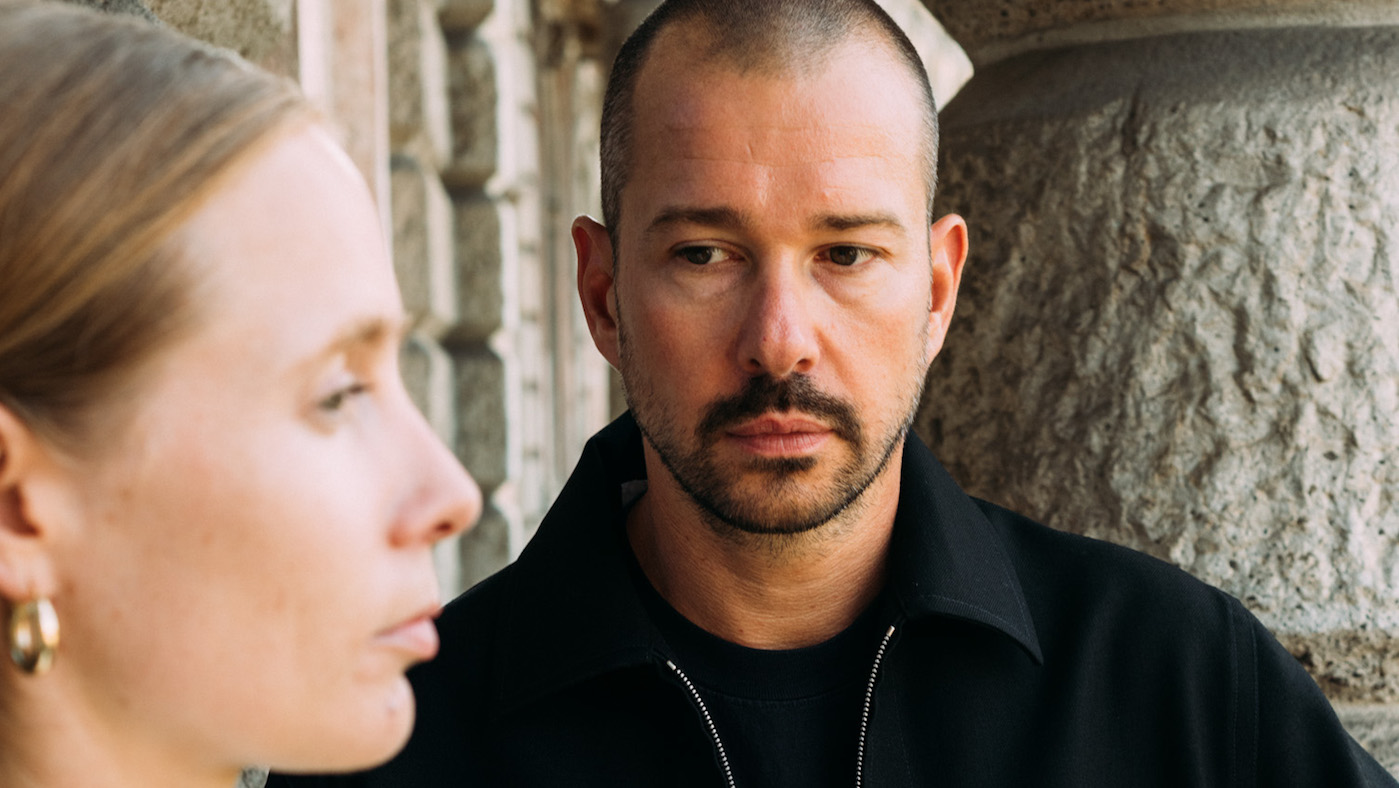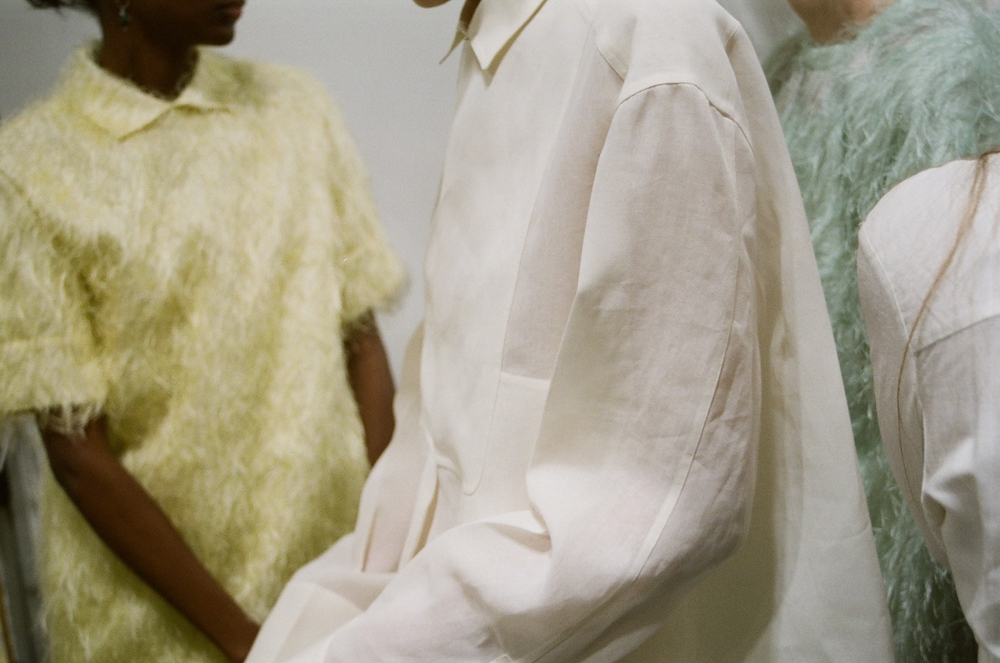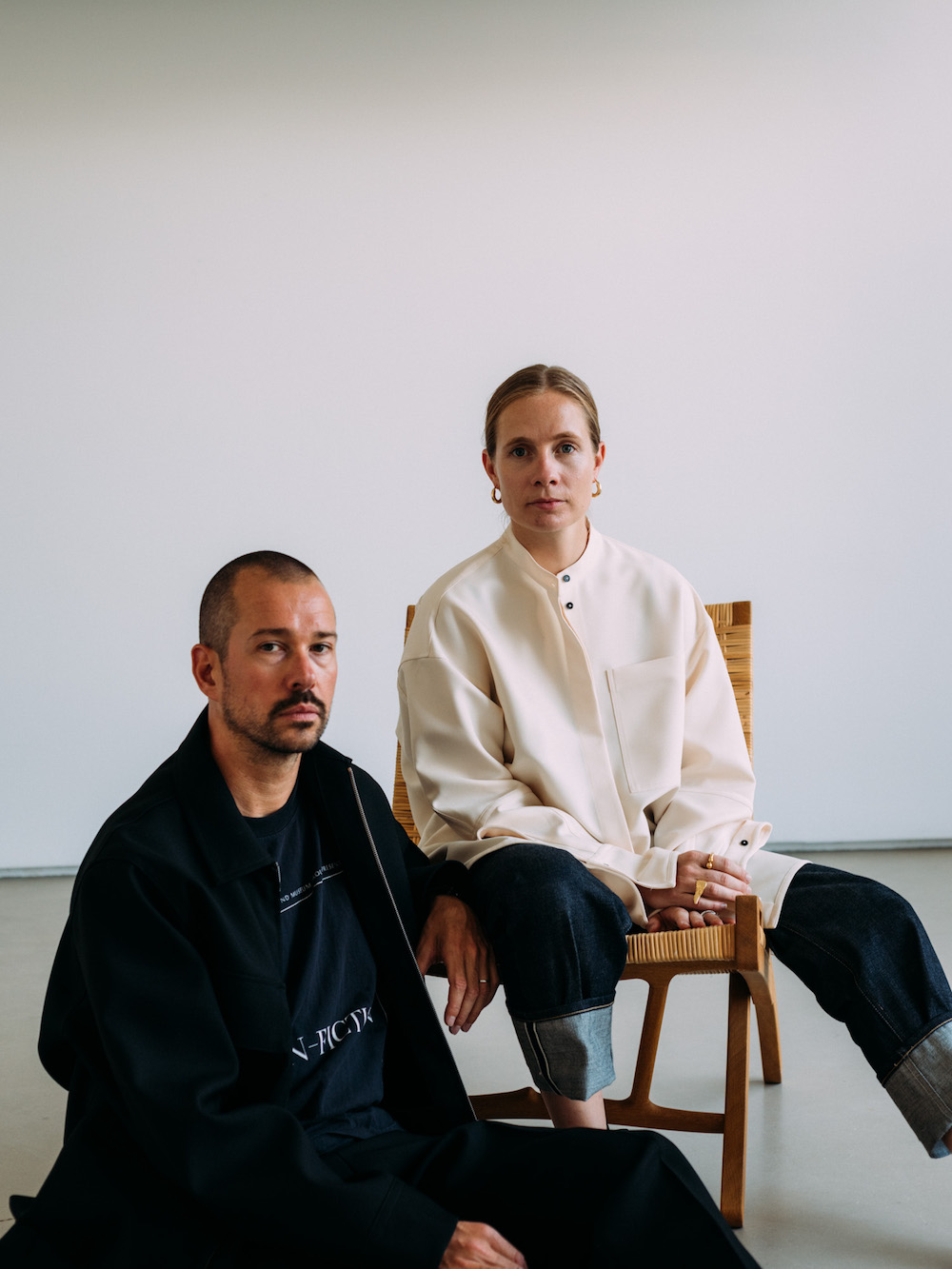Dynamic duo: Lucie and Luke Meier on Jil Sander's new era
The designers' purity of vision is leading Jil Sander towards new and exciting horizons informed by the natural world

At Jil Sander's Milan headquarters, an unarranged medley of plants and seedlings grows in terracotta pots balanced along a balustraded balcony. There is a small flowering orange tree bearing miniature fruit, green-petaled hydrangeas, wild sage and spindly fountaingrasses with pale yellow blades.
By a nearby French window, sacks of compost are stored in an oval metal troth planter. The haphazard display is at odds with Jil Sander's streamlined home: comprising offices, showrooms and workshops, the brand's global nerve-centre occupies several floors of a 19th century palazzo and former theatre with views of the Renaissance Sforzesco Castle.
First drafted by architect and designer Michael Gabellini in 2001, the site's modern interiors are industrial, sparse and near ecclesiastical in their use of light and space. There's a triple-height all-white atrium and a dramatic staircase built from sandstone slabs sourced in Spain and detailed with silver-tone nickel.
The Week
Escape your echo chamber. Get the facts behind the news, plus analysis from multiple perspectives.

Sign up for The Week's Free Newsletters
From our morning news briefing to a weekly Good News Newsletter, get the best of The Week delivered directly to your inbox.
From our morning news briefing to a weekly Good News Newsletter, get the best of The Week delivered directly to your inbox.
Since their appointment as joint creative directors of Jil Sander in April 2017, plant life has played a key role in Lucie and Luke Meier's custodianship of the luxury brand. The husband and wife duo have found their own take on Jil Sander's minimalist DNA, one rooted in nature and emotional connectivity. “There's something nice about leaving your phone and going for a walk in the forest,” says Luke. “We just want to pull that into the work.”
Earlier this year in Paris, the duo added flower seed-bombs to the paper invitations to Jil Sander's Spring / Summer 2020 menswear défilé. The same show featured Jeu d'ombres surréaliste by Debeaulieu florist Pierre Banchereau as a backdrop: a floral shadow play, the temporary installation projected plants and petals against a semi-transparent screen. In Milan, the brand's last two womenswear shows took over a derelict Panettone factory, now gradually returning to nature. “It was this message of nature coming into this raw world,” says Lucie of the venue.

Starting with a new Japan flagship, the twosome is currently in the process of putting their stamp on the brand's stand-alone boutiques, working in partnership with British architect John Pawson. Shell-like in design, Jil Sander Tokyo features pale beige limestone, lime plaster and honey-coloured clear cherry wood; a green-leaved Banyan tree grows over two floors, the top of its canopy extending into the shop's windows.
Overlooking Tokyo's tree-lined Omotesandō avenue, the brand's windows may soon display clothing and accessories labelled Jil Sander+. Unveiled earlier this year, Jil Sander+ is a seasonal wardrobe for explorations en plein air and far away from the city, designed to be worn by the seaside or on top of a mountain. This autumn, the duo has dreamt up plush down jackets, rubber boots, cagoule outerwear and mohair blankets, all produced in a subdued colour palette. “We like nature a lot,” Luke explains. “I think that's just pretty much a function of where we grew up.”
A free daily email with the biggest news stories of the day – and the best features from TheWeek.com
Born in Vancouver to an English mother and Swiss father, Luke left Canada to enrol in finance and international business at Georgetown University in Washington, D.C. Crossing the Atlantic post graduation, he continued his education at the University of Oxford – reading business policy – before darting back to New York City. While studying at the Fashion Institute of Technology and skateboarding off-campus, Luke met James Jebbia, the American-English founder of streetwear phenomenon Supreme. Luke joined Jebbia's burgeoning brand as design director, remaining with the company for eight years. In 2013, he established menswear marque OAMC with Arnaud Faeh; the successful partnership continues to this day.
It was while learning about knitwear design as an exchange student at Polimoda fashion college in Florence, Italy that Luke met Lucie. “It was across a smoky room, I was really sad, looking down in my drink,” he jokes. The reality of their meeting is no less cinematic. Lucie, the daughter of an Austrian mother and German father had arrived in Florence from her Swiss hometown Zermatt to study fashion marketing at Polimoda; both Lucie and Luke rented lodgings at a local family's home. “It's funny, we talked a lot about working together one day. It kind of came around sooner than we imagined,” says Luke.
Leaving Florence for Paris, Lucie studied fashion design before joining Marc Jacob's Louis Vuitton ateliers in 2008. After five years, the designer joined Balenciaga in 2012, where she worked with the maison's then creative director Nicolas Ghesquière. In the 2014, Raf Simons cherry-picked Lucie to act as head designer of haute couture and ready to wear during his tenure as the brand's creative director. When Simons eventually left Dior in 2015, she led the brand's design team alongside her colleague Serge Ruffieux.
Jil Sander had long been at the back of Lucie's mind: her mother was an avid collector and wearer of the brand's minimal designs. “She was quite a big fan,” she says, remembering family excursions. “When we went to a city where there was a shop, we'd have to go and see it. I've always admired the brand.”
The brand's 2017 announcement made Lucie and Luke the first married couple to creatively lead a global luxury brand. “It was always the ultimate goal,” says Lucie of working with her husband of 15 years. “There is no free time when you do this kind of work. If you do it together, [you] actually manage to hang out.”
Following their first collection for Resort 2018, Lucie and Luke made their official Jil Sander debut with the brand's SS20 runway show in Milan. Identifying tailoring and shirting as among the brand's building blocks, the designers presented variations of full-length shirt dresses and two-piece suits that stood out for their economy of line, all rendered in prestige materials. “We wanted to start a new chapter, our chapter for this brand. The foundation in a way,” says Lucie, remembering that first show which took place by architect Zaha Hadid's Generali Tower. “A white shirt just comes to mind when you think of Jil Sander.”
A former fashion journalist and alumnus of the Krefeld School of Textiles, Heidemarie 'Jil' Sander produced her first garments in 1968 which she sold in her Hamburg multi-brand boutique. In 1975, the brand made its Paris fashion week debut. Sander's stark, minimalist designs proved ahead of their time; despite teething problems, the German designer persevered, eventually celebrating global success and critical acclaim. In 1999, Italian fashion house Prada purchased a 75% stake in the business; Jil Sander has since been sold twice. The brand's Milan headquarters have witness their fair share of musical chairs: there have been three creative directors – including Raf Simons (2005 to 2012) – before Lucie and Luke's arrival, and the founder herself has returned and left twice. “I had followed the brand for a long time and it's always been a reference of sorts,” says Luke. “The image was that it was quite particular as far as the aesthetic and the direction. It always felt quite impressive.”

At Jil Sander's Milan atelier, Lucie and Luke let materials and fabrications guide their work. The designers' focus on technique and choice materials is absolute. Theirs is an empathetic type of luxury, one that aims to forge an emotional connection between maker, product and customer. “To me, the greatest luxury is time,” explains Luke. “When you talk of something hand-made, there's always this sort of shadow behind it of the time it takes. Whether it's the time that it's taken somebody to get that skill for what they're doing, or the actual manual labour to produce it. In a way, handiwork is a very beautiful symbol of this idea of time.” Adding a human touch to minimalism, Lucie and Luke's new Jil Sander produces designs such as the best-selling Tangle bag, worn with a hand-woven leather strap and a line of hand-made jewellery crafted from eco brass and hardstones. Elsewhere, a double-breasted wool and cashmere coat celebrates highly-skilled tailoring in a precise silhouette and drape.
This autumn, in addition to Japanese fabrics the duo explored wool felt. Presented alongside silk and leather designs, tailored and sculpted felt gowns, caban jackets and great-coats are striking for their sculptural, cocoon-like silhouette. “It's a very pure, natural fibre,” says Luke. “You just cut and sew and with a little steaming it becomes this beautiful form.” The designers seek beauty and authenticity in natural materials. “It gives it more life, otherwise it's too austere, too perfect,” Lucie explains their choice. “I think that's not what we want.”
During this year's Salone del Mobile furniture fair, Gabellini's Jil Sander showroom turned greenhouse as Lucie and Luke invited Australian artist Linda Tegg to install her work Adjacent Field. Foraging and replanting often overlooked local flora, Tegg created islet-like patches of green growing in nursey crates and geotextile bags. Tegg's work chimed with the Meiers' vision for Jil Sander. “I think what we do is very simple: it's stripped-away of superfluous things. We are always searching for purity of sorts,” says Luke.
Portraits by Frederico Ciamei
-
 7 bars with comforting cocktails and great hospitality
7 bars with comforting cocktails and great hospitalitythe week recommends Winter is a fine time for going out and drinking up
-
 7 recipes that meet you wherever you are during winter
7 recipes that meet you wherever you are during winterthe week recommends Low-key January and decadent holiday eating are all accounted for
-
 Nine best TV shows of the year
Nine best TV shows of the yearThe Week Recommends From Adolescence to Amandaland